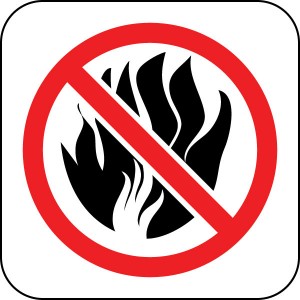Don’t Let It Happen To You
March 27, 2012
Filed under Blog
Fire Safety Tips for Your Home, Part 2

This week, we’re continuing our two-part series on fire safety tips for the home. Did you know that the kitchen is the leading area of origin for home structure fires, and cooking is the leading cause of home structure fires (per the NFPA)? Home structure fires tend to peak around the dinner hour, between 5pm and 8pm. So–all seriousness aside, one can logically conclude that we must all stay out of our kitchens and eat out as often as we possibly can, especially in the evenings! What a boost to the economy that would be! Now for the real important stuff that may help save your home and your life…
Establish a fire safety and escape plan for your home. Develop it with your family so that everyone understands the importance of it. Make sure you have two exits out of every room. Run practice drills from time to time to keep the plan fresh in everyone’s mind, particularly if you add a new family member to your home.
 If you have a wood-burning fireplace, whether you use it seldom or often, you would be wise to install a spark arrestor on your chimney to prevent embers from landing on your roof. It ranges in price from $30-$75, and is a small price to pay to prevent a house fire. Your chimney top should have at least a 10-foot clearance from trees, so stay on top of your tree-trimming.
If you have a wood-burning fireplace, whether you use it seldom or often, you would be wise to install a spark arrestor on your chimney to prevent embers from landing on your roof. It ranges in price from $30-$75, and is a small price to pay to prevent a house fire. Your chimney top should have at least a 10-foot clearance from trees, so stay on top of your tree-trimming.
And while you’re trimming those trees away from your roof and chimney, also remember to keep branches trimmed back and away from electrical lines which can spark from time-to-time. You will also want to keep brush, weeds, grass and debris away from all of your structures. Clean leaves and debris off your roof and out of your rain gutters. All of this dry material makes excellent kindling for starting a fire.

Space heaters work well in small spaces, but don’t use them in TOO small and cramped of a space. These heaters require a 3-foot perimeter, so give them room to work safely and efficiently. Keep them away from bedding, mattresses, clothing, upholstery, and draperies, all of which can go up in flames rather quickly.
 Never overload your electrical sockets, or they could overheat and burn. If you notice black marks or scorch marks around a socket, unplug the cords from it and have it checked out. When using extension cords, don’t run them under rugs or carpets, which can catch fire due to overheating, or due to a frayed or loose wire in the cord.
Never overload your electrical sockets, or they could overheat and burn. If you notice black marks or scorch marks around a socket, unplug the cords from it and have it checked out. When using extension cords, don’t run them under rugs or carpets, which can catch fire due to overheating, or due to a frayed or loose wire in the cord.

Garages and sheds have their own set of hazards. If you regularly store gasoline, make sure it is stored in approved, spill-proof safety cans. For you painters and refinishers, always keep the lid on containers of paint or flammable solvents. Because we tend to reuse rags that get oily and don’t wish to discard them immediately, metal cans with lids are the perfect container for oily, combustible rags.
Smokers can use a few simple reminders, too. While it seems like a complete no-brainer–never, ever smoke in bed. Choose deep ashtrays that will not tip over, and be sure to wet the contents before dumping. Most importantly, keep lighters and matches out of the reach of children.
Fire safety tips could indeed provide endless material for an article, but hopefully, in these two issues, you have identified a few tips that you can zero in on. If you stay alert and are conscious of your indoor and outdoor living space, use common sense, and do regular maintenance, you will be ahead of most people in keeping your home safe.
